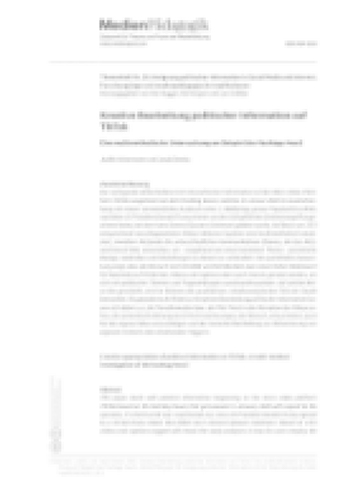Abstract
As a result of the algorithmic revolution, many of us are now carrying a high-performance computer in their pockets, and have others waiting at home. With the Internet, these computers have been integrated into an attractive medium. A new kind of thinking is emerging with this unique turn-over of all the technological infrastructure of culture: algorithmic thinking. Only few realise that this kind of thinking is a thinking towards computability, and to the machine. As such it is narrowing thought. Humans are capable of continued interpretation without limits. The world of machines, on the other hand, must necessarily limit interpretation to unique determination. Current culture is caught in this contradiction. In art, closing-down algorithmics encounters opening-up aesthetics. In algorithmic art, now more than fifty years old, both meet. In this encounter we expect chances for educational processes. What should young people know about impacts of their way of communicating? How can they come to understand that their way of communication depends on the permanent activity of algorithms and data-structures? How can they see that a semiotic layer of reality is simulating and preparing for the changes of the physical world? Simulation and automation have always been subject matter of computing, algorithms and data-structures are its means. Design of contents and instrumental use have always belonged to media education. What of this must today become part of a general education, and how? – We are concerned about this question in the context of introducing the discipline of computing in primary school already. This essay is about «algorithmic thinking» which is basic for an understanding of digital computing. We show examples of how to learn algorithmic thinking by studying works of art, and what role there is for algorithmic art, in particular. Our discussion is on the level of disciplinary skills. But we see how important it becomes to leave behind the confines of discipline if we want to achieve good general education.
References
Bandura, Albert. 1994. Lernen am Modell. Ansätze zu einer sozial-kognitiven Lerntheorie. Stuttgart: Klett-Verlag.
Bill, Max. 2009. «Ausdehnung von Gelb». In Konkret: die Sammlung Heinz und Anette Teufel im Kunstmuseum Stuttgart, herausgegeben von Simone Schimpf und Kunstmuseum Stuttgart. Bd. 1. Bestandskatalog / Kunstmuseum Stuttgart, S. 75. Ostfildern: Hatje Cantz-Verlag.
Dewey, John. 2000. Demokratie und Erziehung. Eine Einleitung in die philosophische Pädagogik. Hrsg. von Jürgen Oelkers. Weinheim, Basel: Beltz (Amerikanische Originalausgabe 1916).
Grabowski, Susanne. 2006. «ZeichenRaum: digitale Medien in Studienumgebungen am Beispiel der Computerkunst». Dissertation, Bremen: Universität Bremen. https://nbn-resolving.org/urn:nbn:de:gbv:46-diss000108784.
K–12 Computer Science Framework. 2016. https://k12cs.org/wp-content/uploads/2016/09/
K%E2%80%9312-Computer-Science-Framework.pdf.
Kant, Immanuel. 1966. «Beantwortung der Frage: Was ist Aufklärung?» Werke, Bd. VI, 51-61. Darmstadt: Wiss. Buchgesellschaft.
Klee, Paul. 1992. «Architektur aus Variationen (1927)». In Computer und Kunst. Programmierte Gestaltung: Wurzeln und Tendenzen neuer Ästhetiken, herausgegeben von Erwin Steller. S. 328. Mannheim, Leipzig, Wien, Zürich: BI Wissenschaftsverlag.
Molnar, Vera. 196 carrés. 1979. Fotografie mit Genehmigung der Kunsthalle Bremen 2016.
Molnar, Vera. 2006. «Structures de quadrilatères (Viereckstrukturen), 1986». In monotonie, symetrie, surprise, herausgegeben von Wulf Herzogenrath, und Barbara Nierhoff. Ausstellungskatalog Kunsthalle Bremen.
Nake, Frieder, und Susanne Grabowski. 2001. «Human–Computer Interaction Viewed as Pseudo-Communication». Knowledge-Based Systems 14 (8): 441–47. https://doi.org/10.1016/S0950-7051(01)00140-X.
Nake, Frieder. 2001. «Das algorithmische Zeichen». In Informatik 2001: Wirtschaft und Wissenschaft in der Network Economy – Visionen und Wirklichkeit, Tagungsband der GI/OCG-Jahrestagung, herausgegeben von Kurt Bauknecht, Wilfried Brauer, und Thomas A. Mück, 2:736–42. Schriftenreihe der Österreichischen Computer-Gesellschaft 157. Konstanz: UVK.
Nake, Frieder, und Susanne Grabowski. 2005. «Zwei Weisen, das Computerbild zu betrachten». In HyperKult II. Zur Ortsbestimmung analoger und digitaler Medien, herausgegeben von Martin Warnke, Wolfgang Coy, und Georg Christoph Tholen. Bielefeld: transcript Verlag. https://doi.org/10.14361/9783839402740-005.
Nake, Frieder. 2009. «The Semiotic Engine: Notes on the History of Algorithmic Images in Europe». Art Journal 68 (1): 76–89. https://doi.org/10.1080/00043249.2009.10791337.
Nees, Georg. 1965. «Andreaskreuz». In 1965. rot 19. Computer Grafik, herausgegeben von Max Bense und Elisabeth Walter, S. 9. Stuttgart. Druck Hansjörg Mayer.
Noll, A. Michael. 1966. «Human or machine: A subjective comparison of Piet Mondrian's ‹Composition with Lines› (1917) and a computer-generated picture». The Psychological Record, vol. 16 (1): 1-10. https://doi.org/10.1007/BF03393635.
Mondrian, Piet. 1992. «Pier and Ocean. Komposition mit Linien (1917)». Computer und Kunst. Programmierte Gestaltung: Wurzeln und Tendenzen neuer Ästhetiken, herausgegeben von Erwin Steller. S. 325 f. Mannheim, Leipzig, Wien, Zürich: BI Wissenschaftsverlag.
Reas, Casey, und Ben Fry. 2016. Processing. A programming handbook for visual designers and artists. Cambridge, MA: MIT Press. 2nd ed.
Repenning, Alexander. 1991. «Creating user interfaces with Agentsheets». In [Proceedings] 1991 Symposium on Applied Computing, 190–96. Kansas City, MO, USA: IEEE Comput. Soc. Press. https://doi.org/10.1109/SOAC.1991.143873.
Repenning, Alexander. 1993. «Agentsheets: A Tool for Building Domain-Oriented Dynamic, Visual Environments». Dissertation, Boulder, CO: University of Colorado. https://www.cs.colorado.edu/~ralex/papers/PDF/Repenning-PhD.pdf.
Repenning, Alexander. 2015. Computational Thinking in der Lehrerbildung. Zürich: Schriftenreihe der Hasler Stiftung. http://www.fit-in-it.ch/sites/default/files/downloads/schrift_repenning-1411-gzd_deutsch_0.pdf.
Research Committee. 2011. Seven Big Ideas of Computer Science. Seattle: University of Washington https://csprinciples.cs.washington.edu/sevenbigideas.html
Schelhowe, Heidi. 1997. Das Medium aus der Maschine. Frankfurt a.M.: Campus.
Steller, Erwin. 1992. Computer und Kunst. Programmierte Gestaltung: Wurzeln und Tendenzen neuer Ästhetiken. S. 328. Mannheim, Leipzig, Wien, Zürich: BI Wissenschaftsverlag.
Turing, Alan Mathison. 1937. «On Computable Numbers, with an Application to the Entscheidungsproblem». Proceedings of the London Mathematical Society s2-42 (1): 230–65. https://doi.org/10.1112/plms/s2-42.1.230.
von Hentig, Hartmut. 1985. Die Menschen stärken, die Sachen klären. Ein Plädoyer für die Wiederherstellung der Aufklärung. Stuttgart: Reclam.
Wehrli, Ursus. 2002. Kunst aufräumen. S. 4–5. Zürich: Kein & Aber.
Weizenbaum, Joseph. 1978: Die Macht der Computer und die Ohnmacht der Vernunft. Frankfurt a.M.: Suhrkamp (Originalausgabe 1976).
Wilkens, Ulrike. 2000. Das allmählichen Verschwinden der informationstechnischen Grundbildung. Zum Verhältnis von Informatik und Allgemeinbildung. Herzogenrath: Shaker Verlag.
Wing, Jeannette M. 2006. «Computational Thinking». Communications of the ACM 49 (3): 33–35. https://doi.org/10.1145/1118178.1118215.
Zitzler, Eckart. 2017. Dem Computer ins Hirn geschaut. Informatik entdecken, verstehen und querdenken. Berlin, Heidelberg: Springer. https://doi.org/10.1007/978-3-662-53666-7.

